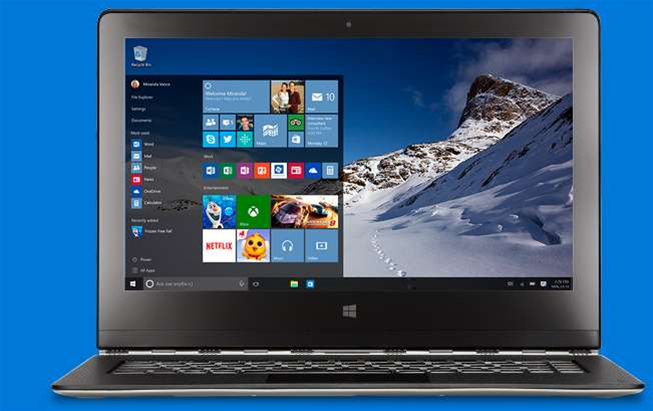Enterprise-class security

When it comes to security issues, it seems hardly a mainstream operating system has managed to come away from the last 12 months unscathed.
For Windows 10, Microsoft has targeted identity theft and focused on passwords as one of the major threats to system security.
To that end, it signed up to the FIDO (Fast Identity Online) Alliance, the global group aimed at improving and standardising online authentication. It also provided input into the new FIDO 2.0 standard that’s been introduced into Windows 10.
The most obvious way you’ll see this implemented is via a new two-factor biometric authentication feature called Windows Hello. Built around fresh application programming interface (API) additions collectively known as Microsoft Passport, it allows users (and developers) to incorporate iris, facial or fingerprint scanning technology as one of the authentication factors.
One interesting off-shoot from this is new tech that will provide the required 3D security scanning. Mobile chipmaker Qualcomm recently announced a new ultrasonic-based 3D fingerprint scanning technology that can capture the peaks and troughs of fingerprints for higher-precision security.
We should see Sense ID 3D fingerprint scanning capabilities in next-generation Qualcomm Snapdragon mobile CPUs that support the new Phone version of Windows 10.
Not to be outdone, chip giant Intel has also jumped onboard the 3D scan bandwagon with its new three-camera RealSense technology.
Primarily, Intel is promoting it for use in gaming and photography, but Microsoft has also said the new Intel RealSense F200 3D camera will combine with Windows Hello’s facial unlock feature and automatic sign-in in Windows.
Windows Hello
Guilty by default
Enterprise users will also have exclusive access to the new Device Guard, which Microsoft calls a ‘combination of enterprise-related hardware and software security’.
It enables administrators to lock down enterprise systems into running only apps that have been signed by trusted sources.
According to Microsoft, rather than rely on anti-virus to catch malicious software, Device Guard switches the OS into lockdown mode where only apps trusted by the enterprise will run – basically, switching modes from ‘innocent until proven guilty’ to ‘everyone is guilty unless the enterprise says otherwise’.
DirectX12 and Vulkan
DirectX is Microsoft’s multimedia and graphics extensions and it usually gets far more interest from the gaming community than business, but it should be something to keep a close eye on.
Windows 10 comes with the latest version 12 release and amongst the new features, Microsoft has provided software developers with a much lower-level of access to the core silicon inside the graphics processor unit (GPU) that runs most graphics cards.
Think of it as something like being able to delve into your car’s engine computer and not just tweak it for more performance, but get right down to basically changing how the engine works.
In the main, the GPU crunches numbers to display high-quality gaming graphics, but thanks to dedicated languages such as OpenCL and Nvidia’s CUDA (Compute Unified Device Architecture) , GPUs now feature highly in parallel-processing applications well beyond gaming.
Software developers can now tap into the GPU and use the latent processing horsepower for more business-oriented applications, such as data science and analytics – and to great effect.
For example, there’s considerable university research into using GPUs in accelerating neural networks. In more mainstream roles, Adobe has for some time offered CUDA co-processing support for Nvidia GPUs in Adobe Premiere video editing software to crank up video rendering speeds.
DirectCompute was DirectX11’s answer to OpenCL and CUDA, further enhanced by Microsoft’s C++ AMP (accelerated massive parallelism) library.
In the meantime, chipmaker and Intel rival AMD created a new GPU graphics language interface called ‘Mantle’, releasing it in mid-2013. However, earlier this year, the company revealed that Mantle had morphed into the new Vulkan cross-platform API from multi-vendor consortium, Khronos, to support both gaming and ‘compute’ (general-purpose processing) on new GPUs.
There are similarities between DirectX12 and Vulkan, but Vulkan has the advantage of OS-independence, opening up GPGPU (general purpose graphics processor unit) coding to a wider range of devices, including smartphones.
Although Microsoft hasn’t yet said much about its general computing capabilities, it's likely DirectX12 will deliver new functionality for high-performance computing on mainstream gaming graphics cards.
And if DirectX12 doesn’t, Vulkan almost certainly will.
Read on for the verdict
Road test before committing.





_(20).jpg&h=140&w=231&c=1&s=0)





 iTnews Executive Retreat - Security Leaders Edition
iTnews Executive Retreat - Security Leaders Edition












_(1).jpg&h=140&w=231&c=1&s=0)



